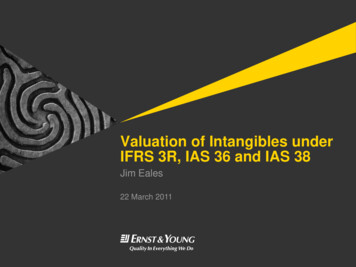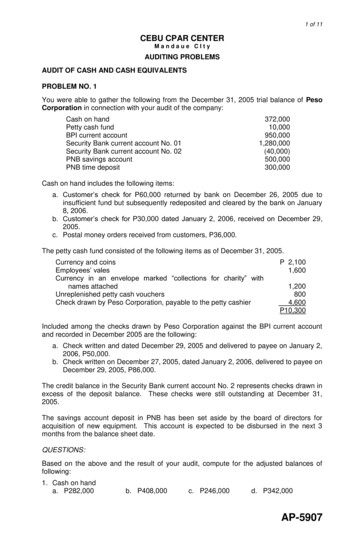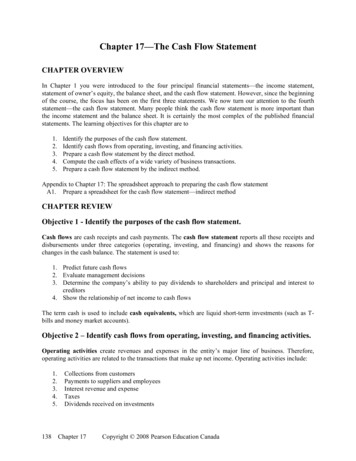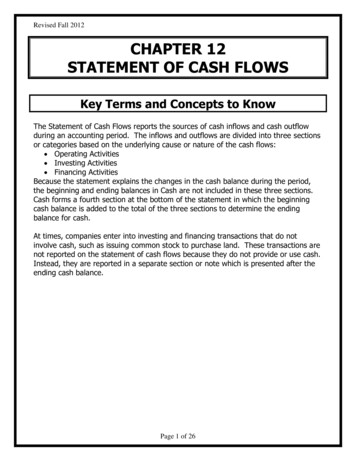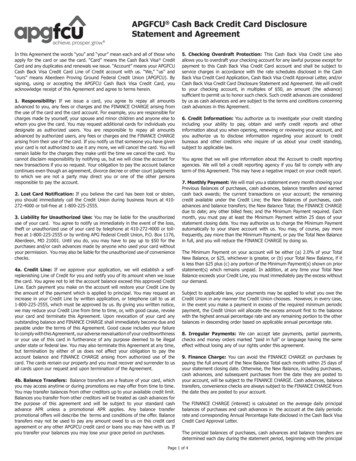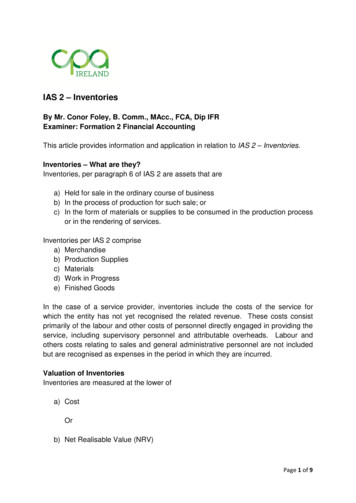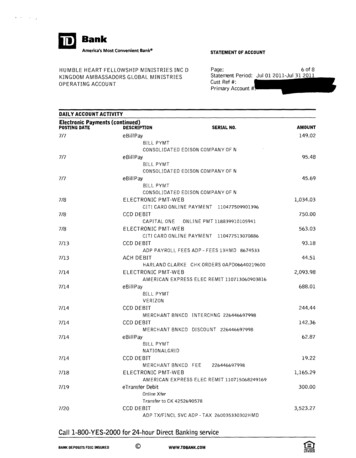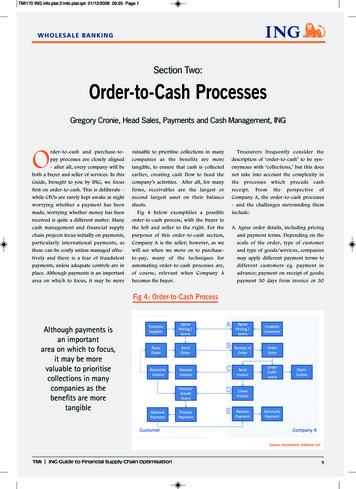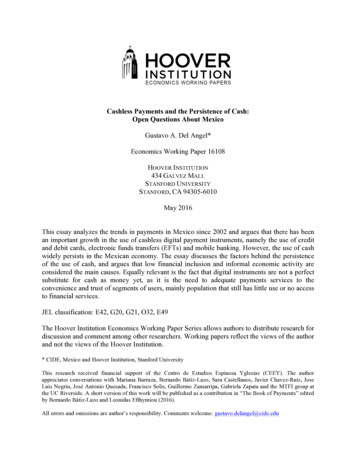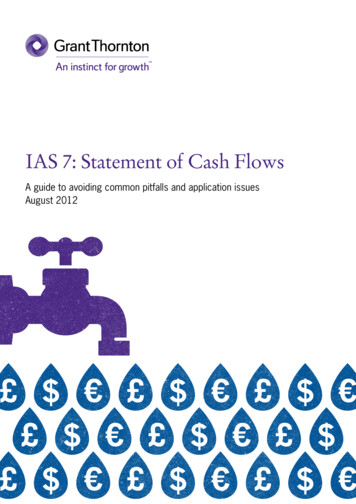
Transcription
IAS 7: Statement of Cash FlowsA guide to avoiding common pitfalls and application issuesAugust 2012
Important Disclaimer:This document has been developed as an information resource. It is intended as a guideonly and the application of its contents to specific situations will depend on the particularcircumstances involved. While every care has been taken in its presentation, personnel whouse this document to assist in evaluating compliance with International Financial ReportingStandards should have sufficient training and experience to do so. No person should actspecifically on the basis of the material contained herein without considering and takingprofessional advice. Neither Grant Thornton International Ltd, nor any of its personnel nor anyof its member firms or their partners or employees, accept any responsibility for any errors itmight contain, whether caused by negligence or otherwise, or any loss, howsoever caused,incurred by any person as a result of utilising or otherwise placing any relianceupon this document.
IntroductionStatement of Cash FlowsThe phrase “cash is king” is not new but becameeven more relevant during the global financial crisis.For some the Statement of Cash Flows is the mostimportant information in the financial statements,as it: provides unbiased, objective information that isrelatively free from estimation uncertainty allows financial statement users to assess anentity’s past forecasts and use that information asthe basis for future decision-making and futureperformance allows financial statement users to compareperformance of various entities across industriesor geographic locations.Cash flow reporting is addressed in InternationalFinancial Reporting Standards (IFRS) by InternationalAccounting Standards (IAS) 7 ‘Statement of CashFlows’ (IAS 7, the Standard). A Statement of CashFlows is part of an entity’s complete set of financialstatements in accordance with paragraph 10 ofIAS 1 ‘Presentation of Financial Statements’ (IAS1.10). Further, IAS 7 requires all entities to present aStatement of Cash Flows – with no exceptions (IAS7.3).The increasing attention on companies’cash generation and liquidity position has led togreater focus on the Statement of Cash Flows byfinancial statement users, regulators and othercommentators. However, this additional focus andscrutiny has also highlighted some common errorsand inconsistencies in the application of IAS 7.Fortunately, the member firms within GrantThornton International Ltd (Grant ThorntonInternational) – one of the world’s leadingorganisations of independently owned andmanaged accounting and consulting firms – havegained extensive insights into the Statement of CashFlows. Grant Thornton International, through itsIFRS team, develops general guidance that supportsits member firms’ commitment to high quality,consistent application of IFRS. We are pleased toshare these insights by publishing ‘IAS 7: Statementof Cash Flows a guide to avoiding common pitfallsand application issues’ (the Guide) to assist users inaddressing difficult interpretative issues arising fromthe application of IAS 7.Using the GuideThe objectives of the Guide are to: remind management of the basic requirementsof IAS 7 highlight interpretative and practical applicationissues provide management with insights to addressthese issues.To meet these objectives, the Guide is organised asfollows:IAS 7: Statement of Cash Flows i
Overview of the GuideSection A:IAS 7 at a glance Section B:Identifying cash and cash equivalents Defines cash and cash equivalents and discusses application issues related to various instruments(eg bank overdrafts, demand deposits, money market funds, restricted cash) Outlines the requirements for reconciling cash and cash equivalents in the Statement of CashFlows to the cash and cash equivalents balance in the Statement of Financial Position and commonapplication issues in doing soSection C:Classifying cash flows as operating, investing orfinancing activities Outlines the requirements for classifying cash flows as operating, investing or financing activities Provides common examples of cash flows from operating, investing and financing activities Addresses various application issues that arise when classifying cash flows as operating, investingor financing activities Summarises the general presentation requirements of IAS 7Discusses common presentation application issues including:– gross versus net presentation– using the indirect method– impact of a central banking function– disclosure of total interest paid– cash flow per share Provides an overview of the cash flow requirements related to:– business combinations– accounting for groupsAddresses common application issues related to both Provides an overview of the requirements related to cash flows from foreign currency transactionsAddresses common application issues on this topicSection D:Presentation issuesSection E:Group cash flowsSection F:Foreign currency cash flowsGrant Thornton International LtdAugust 20122 IAS 7: Statement of Cash FlowsProvides an ‘at a glance’ overview of IAS 7’s main requirements
ContentsIntroduction iA. IAS 7 at a glance 1B. Identifying cash and cash equivalents 31 Guidance overview 31.1 Defining cash and cash equivalents 2 Application issues2.12.22.32.42.52.63 4Exploring the meaning of ‘short-term’ Bank overdrafts Demand deposits Money market funds Restricted cash Reconciling cash and cash equivalent balances 444568C. Classifying cash flows as operating, investing or financing activities 91 Guidance overview 91.1 Classifying cash flows as operating, investing or financing activities 2 Application issues2.12.22.32.42.52.69 10Interest and dividends Short-term loans to related parties Expenditure on internally generated intangibles Cash flows relating to assets held for rental to others Cash flows relating to a business combination Tax cash flows 111213131313D. Presentation issues 1 Guidance overview 14141.11.21.31415151516Gross cash flows Selecting the direct or indirect methods 1.2.1 Direct method 1.2.2 Indirect method Non-cash transactions
2 Application issues 2.12.22.32.42.52.62.7Gross or net cash flows? Starting point for the indirect method Presentation of adjustments to profit or loss using the indirect method Non-cash transactions Central banking function Disclosure of total interest paid Cash flow per share 1616171717181919E. Group cash flows 1 Guidance overview 2 Application issues 2020212.12.22121222223242424Cash flows relating to business combinations 2.1.1 Deferred consideration 2.1.2 Contingent consideration 2.1.3 Cash and cash equivalents acquired 2.1.4 Transaction costs Other group cash flow considerations 2.2.1 Changes in non-controlling interests 2.2.2 Acquisitions and disposals of subsidiaries F. Foreign currency cash flows 1 Guidance overview 2 Application issues 2.1 Foreign currency exchange differences 2.2 Individual entities 2.3 Foreign operations 262626262728
A. IAS 7 at a glanceSection A:IAS 7 at a glance Reminds readers of the main requirements of IAS 7All entities need cash to run their day-to-day operations, pay their obligations and provide returns toinvestors, regardless of their particular line of business or geographic location. The overall objective ofIAS 7 is to require entities to report their historical changes in cash and cash equivalents by means of aStatement of Cash Flows which classifies the period’s cash flows by operating, investing and financingactivities. As a result, this Statement provides financial statement users with insight to how the entitygenerates and uses cash and cash equivalents.The table below outlines the overall requirements and guidance provided in IAS 7, as well as otherrelated guidance:Table A.1 – IAS 7 at a glance:IAS 7 (or related IFRS) referenceScope(IAS 7.3)(IAS 1.10-11)Presentation(IAS 7.1)(IAS 7.21-24)Benefits of cash flow information(IAS 7.3-4)Requirements All entities must prepare a Statement of Cash Flows The Statement of Cash Flows comprises part of an entity’s “complete set”of financial statements under IFRS1 The Statement of Cash Flows must be presented with equal prominencewith the other statements comprising a complete set of financialstatements1 An entity must include each period for which financial statements arepresented Prescribes that cash flows shall generally be presented on a gross basisand provides exceptions to that general principle Enables users to evaluate an entity’s:– changes in net assets– financial structure, liquidity and solvency– ability to affect amounts and timing of cash flows– ability to generate cash and cash equivalents Allows users to compare entities, irrespective of the nature of the entity’sactivities, industry or geographic location1T his requirement is outlined in IAS 1 ‘Presentation of Financial Statements’, but relates to the Statement of Cash Flows.IAS 7: Statement of Cash Flows: Section A 1
IAS 7 (or related IFRS) referenceRequirementsKey definitions(IAS 7.6) Classification and presentation of cash flows as operating,investing or financing activities(IAS 7.11-20)Special topics(IAS 7.25-42B)Non-cash transactions(IAS 7.43-44)Disclosures(IAS 7.45-52)Defines the following terms:– cash– cash equivalents– operating activities– investing activities– financing activities Provides guidance on how to properly classify cash flows as operating,investing or financing and indicators/examples of such cash flows Requires that cash flows from operating activities be presented usingeither the– direct method whereby major classes of gross cash receipts andgross cash payments are disclosed or– indirect method whereby an entity adjusts profit or loss for the effectsof transactions of a non-cash nature, any deferrals/accruals of past/future operating cash receipts/payments and items of income/expense associated with investing or financing cash flows Provides additional guidance for specific topics (foreign currencytransactions, interest and dividends, income taxes, investments insubsidiaries, associates and joint ventures and changes in ownershipinterests) Investing and financing transactions that do not require the use of cash orcash equivalents shall be excluded from the Statement of Cash Flows anddisclosed elsewhere in the financial statements Prescribes the disclosure requirements related to the Statement of CashFlowsThe following Sections explore selected requirements in greater detail and provide insights on avoidingthe common pitfalls and application issues that regulators and our IFRS experts see in practice.2 IAS 7: Statement of Cash Flows: Section A
B. Identifying cash and cashequivalents Defines cash and cash equivalents and discusses application issues related to various instruments(eg bank overdrafts, demand deposits, money market funds, restricted cash) Outlines the requirements for reconciling cash and cash equivalents in the Statement of CashFlows to the cash and cash equivalents balance in the Statement of Financial Position and commonapplication issues in doing soSection B:Identifying cash and cash equivalents1 Guidance overview1.1 Defining cash and cash equivalentsThe Statement of Cash Flows reflects movements in cash and cash equivalents. The definitions of these termsare therefore central to its proper preparation.IAS 7.6 provides the following definitions: Cash comprises cash on hand and demand deposits. Cash equivalents are short-term, highly liquid investments that are readily convertible to knownamounts of cash and that are subject to an insignificant risk of changes in value.IAS 7.7 goes on to explain that for an investment to qualify as a cash equivalent, it must be held for thepurpose of ‘meeting short-term cash commitments’ rather than for investment or other purposes.Table B.1 – Defining cash and cash equivalents:Highly liquidinvestmentand Short term(say 3 monthsor less) and Cash & cashequivalentsSubject toan insignificantrisk of changesin value and Readilyconvertible toknown amountsof cash and Held to meetshort-term cashcommitments (notfor investmentpurposes) and IAS 7: Statement of Cash Flows: Section B 3
2 Application issues2.1 Exploring the meaning of ‘short-term’IAS 7 does not define ‘short-term’ but does state ‘an investment normally qualifies as a cash equivalent onlywhen it has a short maturity of, say, three-months or less from the date of acquisition’ (IAS 7.7). Consequently,equity or other investments that do not have a maturity date are excluded from cash equivalents unlessthey are, in substance, cash equivalents (see ‘Money market funds’ below). This three month time limit issomewhat arbitrary but is consistent with the concept of insignificant risk of changes in value and a purposeof meeting short-term cash commitments. In our view, exceptions to this three-month time limit are rare andinvestments with a longer maturity at inception may be included in cash equivalents only if there is strongevidence to show that they are, in substance, cash equivalents (see discussion of ‘Demand deposits’ below forexamples).Any investment or term deposit with an initial maturity of more than three months does not become acash equivalent when the remaining maturity period reduces to less than three months.2.2 Bank overdraftsBank overdrafts are generally classified as borrowings but IAS 7.8 notes that if a bank overdraft is repayableon demand and forms an integral part of an entity’s cash management then it is included as a componentof cash and cash equivalents. A characteristic of such a banking arrangement is that the bank balance oftenfluctuates from being positive to overdrawn.2.3 Demand depositsIAS 7 does not provide a definition of a demand deposit. In practice, these are generally considered to bedeposits with financial institutions that are repayable on demand within one working day and withoutpenalty.Other types of deposit accounts need
Benefits of cash flow information (IAS 7.3-4) Requirements All entities must prepare a Statement of Cash Flows The Statement of Cash Flows comprises part of an entity’s “complete set” of financial statements under IFRS1 The Statement of Cash Flows must be presented with equal prominence
